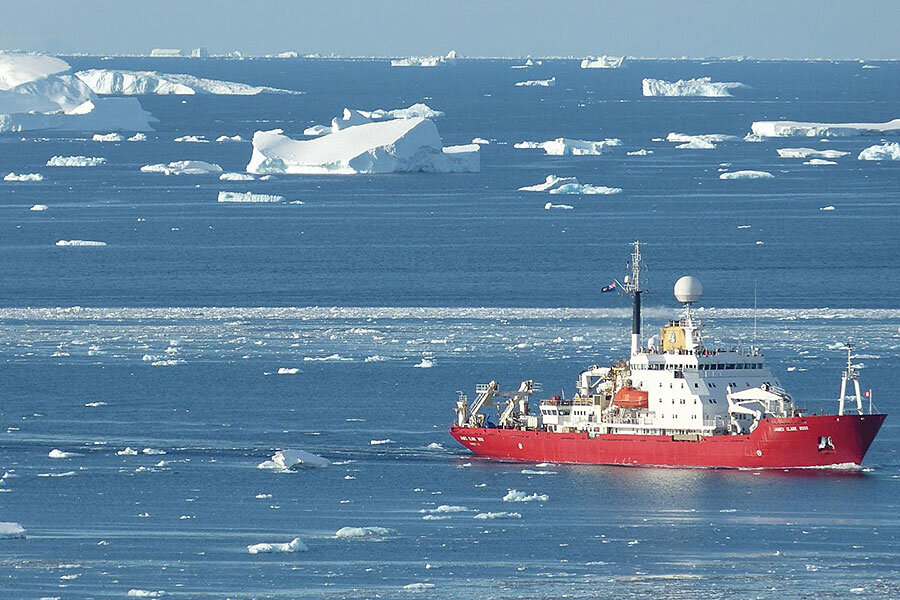How important are warmer seas in the melting of glaciers?
Why are the world’s glaciers melting?
Many would argue the answer is obvious: global warming, driving up the air temperature, causing the ice and snow to liquify. But as a new research paper illustrates, the truth appears to be more complex.
Scientists studying the ice sheet on the western Antarctic Peninsula found a staggering rate of retreat all along the west coast, but the details of the pattern within that analysis led to the conclusion that the primary driver was, in fact, not warmer air temperatures, but warmer oceans. Alongside other research with similar findings, this could have important implications for our understanding, and predictions, of sea-level rise.
“The story they’re telling is consistent with a lot of other lines of evidence,” says Charles Greene, director of the Ocean Resources and Ecosystems Program at Cornell University in Ithaca, New York, who was not involved with the research.
“Probably if you’d looked five years ago, people would have said it was all due to atmospheric temperature,” adds Dr. Greene, “but what we’ve really found in recent years to be the driving force are the warm temperatures melting from below.”
This latest paper, to be published Friday in the journal Science, adds yet another layer of evidence in support of the idea that warmer water plays a crucial role. And, for the first time, the researchers have provided evidence that it is the primary driver in their specific region of study: the western Antarctic Peninsula.
The work had its foundation in a study that lead author Alison Cook, then a PhD candidate at Swansea University in Wales, was undertaking as part of a project spearheaded by the United States Geological Survey, called “Coastal-changes and Glaciological Maps of Antarctica,” sifting through images stored at the British Antarctic Survey.
“The most interesting aspect was looking through historical aerial photographs of this beautiful region of Antarctica!” says Dr. Cook. “It became more fascinating as I realized significant changes could be seen between different images, and once these were mapped the patterns became clear.”
Those patterns revealed a 90 percent rate of overall retreat among the glaciers in that region. But upon closer inspection, the pattern was more distinct.
To the north, the glaciers were relatively stable, but as the researchers cast their eye further south along the peninsula, the rates of retreat rose. What the team also noticed was an accelerated rate of glacial retreat since the 1990s.
In seeking an explanation, they compared the photography and satellite data, which had led to their initial conclusions, with sea temperature records. What emerged was a strong correlation between glacial retreat and the ocean temperatures, which became progressively warmer below 330 feet the further south along the peninsula you chose to look.
Moreover, the warm water at mid-depths so prevalent in the southern reaches has shown increasing temperatures since as far back as the 90s, lending further credence to the hypothesis that warmer waters are the primary driver of glacial retreat in the western Antarctic Peninsula.
But what, exactly, is happening?
“When you have a large ice sheet over the continent, and it meets the ocean, it then extends out into the water – but it’s not floating,” explains Dr. Greene. “It’s running aground. It intersects the bottom, something we call the grounding line.”
This part of the ice is called an ice shelf, and because of the topography of the sea floor, there are plenty of gaps, where ocean water fills spaces between the ice and ocean bottom. In this way, when the temperature of that ocean water rises, it melts the ice from below.
This can destabilize the ice, accelerate its seaward travel and prompt more hunks to break off at its outer edge, there to float away as icebergs and melt into the surrounding water.
“As a result of this study, new predictions of sea-level rise from Antarctic Peninsula ice loss will need to incorporate mid-depth ocean warming as the primary driver of glacier change,” says Cook. “This will therefore help to improve predictions of sea-level rise.”
And herein lies the key, in terms of the study’s import, says Greene: It feeds into the growing body of evidence that underscores the importance of ocean warming in the melting of ice shelves.
This matters because ocean warming melts the ice far more quickly than increasing air temperatures. Understanding this allows scientists to better predict the rates of melting, and thereby the likely sea-level rise.
Back in 2007, when the importance of ocean warming on melting ice sheets was little known, the Intergovernmental Panel on Climate Change brought out a report, in which they predicted that by the end of the 21st century, the level of our oceans could rise by up to half a meter.
Greene worries that, should we carry on as we are, this figure could more accurately lie between one and three meters.
“I’m not saying it’s going to happen,” says Greene. “But our understanding has changed, so if we continue with business as usual with regard to greenhouse gas emissions, we could be looking at really catastrophic sea-level rise by the end of the century.”









